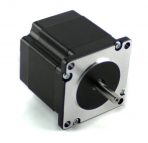Have you ever thought about how a robotic arm moves with precision or how graphic printers create accurate replications of images, or how consumable products are moved precisely around a plant floor or any other type of motion control positioning system?
With this lesson and others to follow you will learn about motion control using different types of motors available, primarily stepper and servo motors.
You can also buy stepper motor at https://www.automationtechnologiesinc.com/products-page/stepper-motors.

Selecting between a servo motor and a stepper motor can be quite a challenge with the balancing of several design factors in cost considerations, torque, speed, acceleration, and drive circuitry all play an important role in selecting the best motor for your application.
Stepper motors have a permanent magnetic rotating shaft called a rotor and stationary electromagnets surrounding the rotor called the stator.
Each permanent magnet pole offers a natural stopping point for the motor shaft.
The greater number of poles allows for a stepper motor to position itself accurately and precisely between each of the poles.
When we want to increase the resolution or achieve the smallest rotational movement, the design of the stepper will contain a larger number of magnetic poles.
Basically, the incremental step size of a stepper motor is fixed to a certain degree of rotation based on the number of electromagnet poles. Therefore, moving to an accurate position is simply a matter of sending the correct number of pulse commands.